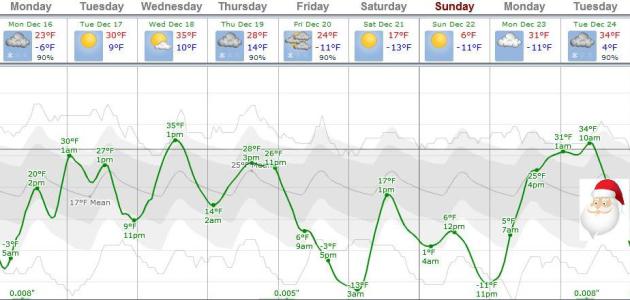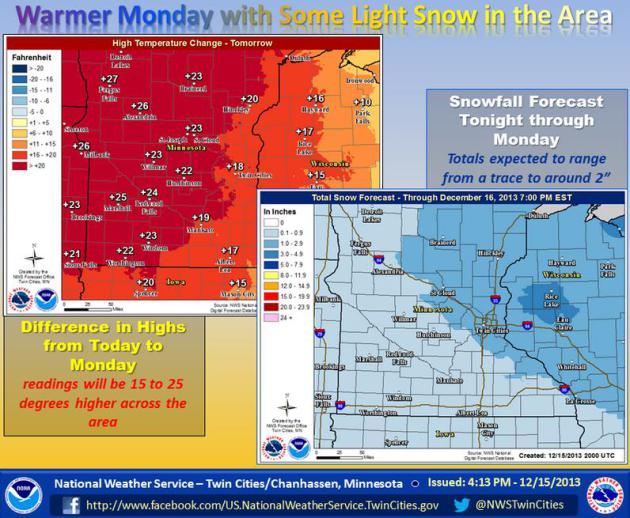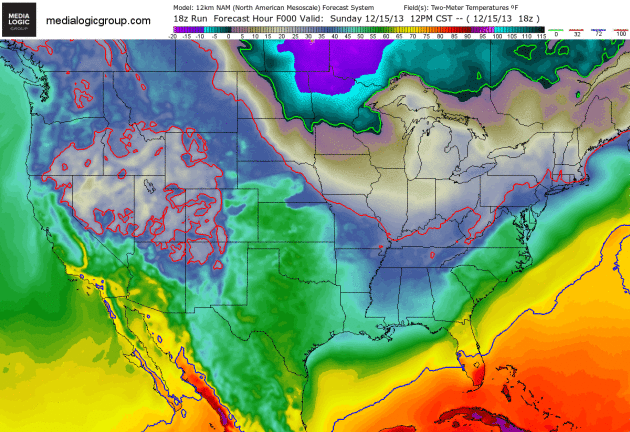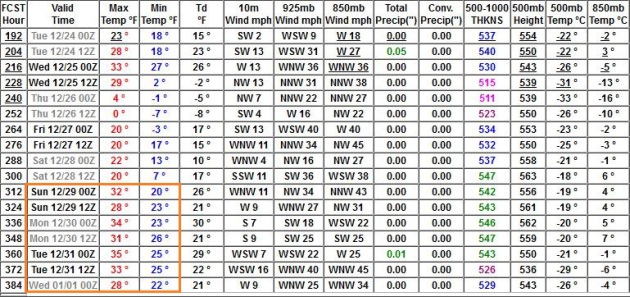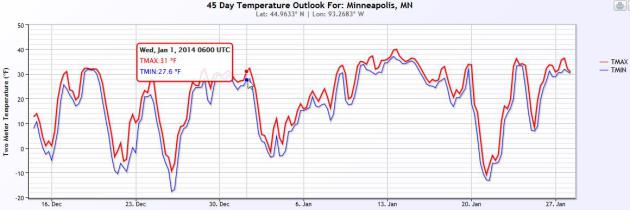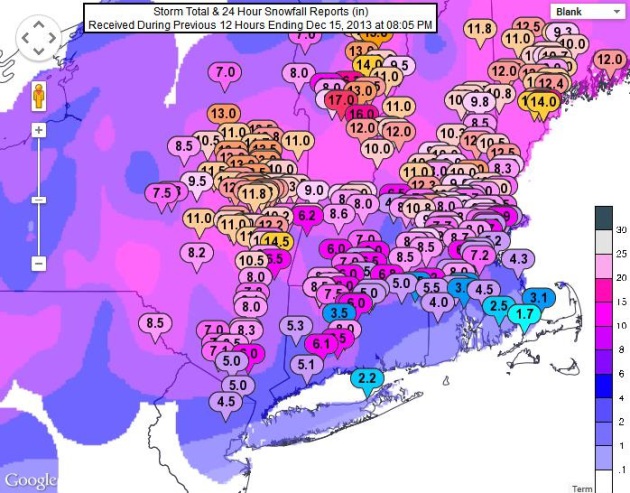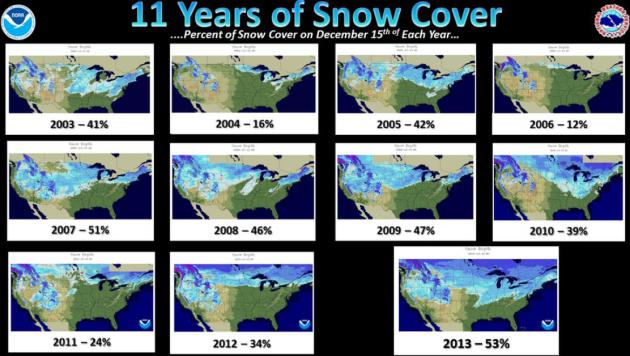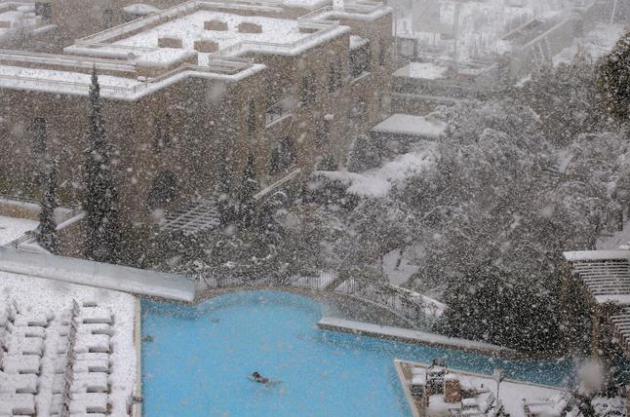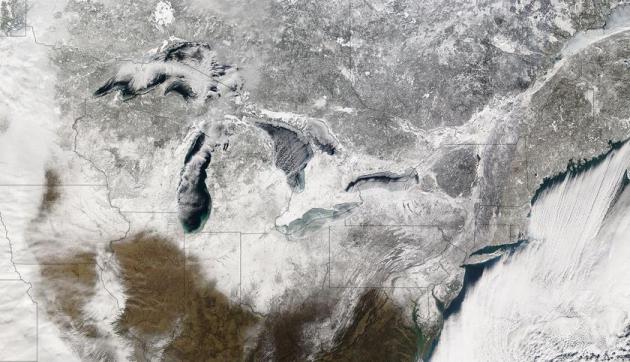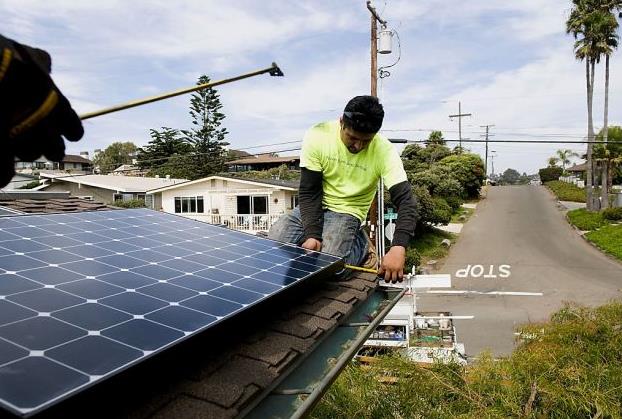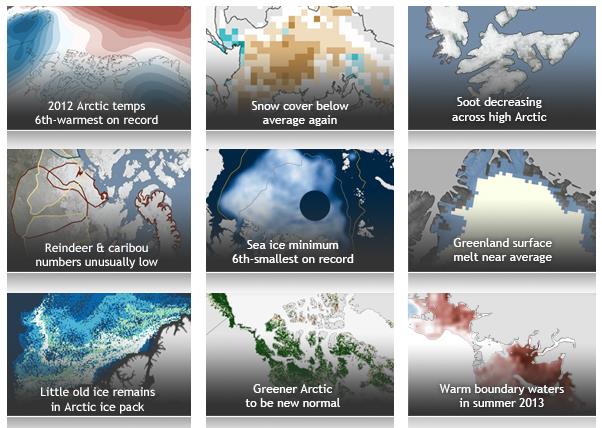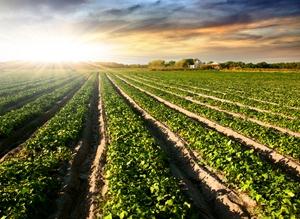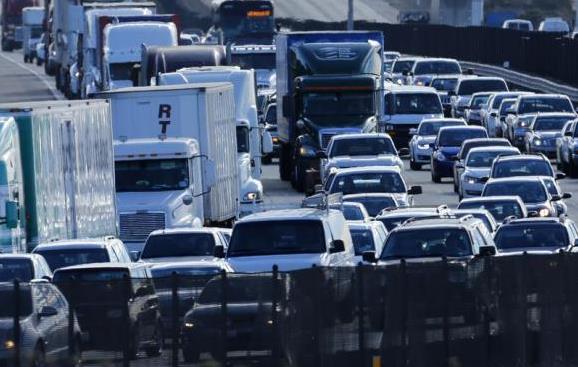Christmas Lights
By
the time December rolls around I feel like a zombie-extra in "The
Walking Dead". It isn't the cold, the snow or even raging
holiday-shopping-post-traumatic-stress disorder. It's a dire lack of
sunlight that has me blue.
Today we'll see 8 hours, 47 minutes of
daylight. That compares with 15 hours, 37 minutes on June 21. Many of
have at least a mild case of SAD, Seasonal Affective Disorder. That's
one reason why we hang strands of holiday lights on our homes; an
electrified version of an 18th century tradition - when Germans put
candles on their Christmas trees to brighten up an otherwise-dark and
somber midwinter sky.
Positive spin: we pick up 3 minutes of
daylight by December 31; temperatures start to rise, at least
historically, about 3 weeks later.
Another clipper brushes us with
a coating to 1 inch today; more north and east of the Twin Cities. No
big storms are brewing between now and Christmas, at least close to
home.
After enduring snow & ice last weekend highs surge into
the 50s on the East Coast next weekend, while we enjoy another brief
polar plunge. Models show another upward blip in temperature next week;
maybe 30s on Christmas Eve?
The way this month is going I'd call that a "warm front".
More Ups Than Downs.
I'm finally seeing more evidence of a milder trend, after a couple of
January-like weeks in early and mid December. Expect 20s today, a shot
at 30F. Tuesday and Wednesday, before cooling back down late in the
week. The ECMWF is consistently showing 30s for Christmas Eve.
A Rather Pathetic Warm Front.
Where else in North America, other than the Yukon and maybe the North
Slopes of Alaska, would the locals cheer for a forecast high in the 20s.
If it hits the 30s you may be tempted to take off your shirt and brush
the snow off the grill. Here in the Land of Low Weather Expectations
we're grateful for small things. Graphic: Twin Cities National Weather
Service.
In Retreat.
The core of the subzero air is lifting rapidly north, a slight twist in
the jet stream steering winds allowing 20s and 30s to return in the
coming days, a few degrees above average for a change. By next weekend
highs may surge into the 50s (with heavy rain) across much of the East
Coast of the USA. NAM 2-meter temperatures out 84 hours, courtesy of
NOAA and Ham Weather.
More Signs Of A Shift In The Pattern.
We'll see more arctic fronts in January, little doubt about that, but
I'm seeing more signs of moderation the last 3-4 days of 2013 which each
passing model run. You may be able to regain feeling in your toes in
time for New Year's Eve parties as highs surge into the 30s, according
to GFS guidance.
Another Wish-Cast.
I actually wish this 45-day trend from NOAA's CFS model comes true,
showing temperatures consistently above average for much of January,
with a string of 30F+ days January 6-20. I wouldn't place any bets, but I
still think there's a good chance that December may wind up a bit
colder than January, overall. That doesn't happen very often. Graphic:
Ham Weather.
New England Snowfall Amounts.
Parts of the Hudson River Valley picked up over a foot of snow, some
2-5" amounts of slush in New York City before it mostly-melted on
Sunday. The Boston area saw plowable amounts of 4-8". Map: NOAA.
Most December 15 Snow Cover In 11 Years. Map and data above courtesy of the
Kansas City office of the National Weather Service.
Some Weather-Climate Perspective On Egypt Snowfall. Snow in Cairo disproves the atmosphere is warming, right? Not so fast, argues
J. Marsh, Director of Atmospheric Sciences Program at the University of Georgia: "...
Legendary
meteorologist and mathematician, Ed Lorenz, reminded us decades ago
that the atmosphere (i.e., weather and climate) is not linear. As
such, when someone makes a statement about climate change based on a
cold day/week or snowstorm in Egypt, it sends a calling card on their
background in atmospheric sciences and understanding of the
non-linearity of the atmosphere. Any properly trained meteorologist
knows that (a.) cold/warm events are influenced by wave patterns in the
atmosphere, jet streams, and other processes (e.g., think of pushing
down one part of a kid’s inflateable- one area goes down, another area
rises), (b.) El Ninos and Arctic Oscillations play a role in weather,
and (c.) a warmer atmosphere holds more water vapor. These things play out within a larger climate system that is likely changing too..."
Photo credit above: "
A
woman swims in the pool at the David Citadel Hotel during a snowstorm
of rare intensity in Jerusalem, Dec. 13, 2013. Snow blanketed Jerusalem
and parts of the occupied West Bank Friday, choking off the city and
stranding hundreds of vehicles on impassable roads." (Brian Snyder/Pool via The New York Times)
Scientists Turn Their Gaze Toward Tiny Threats To Great Lakes.
The problem? Tiny bits of plastic (no larger than the period at the end
of this sentence), too small to be filtered out by sewage treatment
plants. Here's the intro to a troubling story at
The New York Times: "...
The
newest environmental threat to the Great Lakes is very, very small.
Tiny plastic beads used in hundreds of toiletries like facial scrubs and
toothpastes are slipping through water treatment plants and turning up
by the tens of millions in the Great Lakes. There, fish and other
aquatic life eat them along with the pollutants they carry — which
scientists fear could be working their way back up the food chain to
humans..."
What Happened On Easter Island - A New (Even Scarier) Scenario. One word: rats. Here's a clip from Krulwich Wonders at
NPR: "...
What
if the planet's ecosystem, as J.B. MacKinnon puts it, "is reduced to a
ruin, yet its people endure, worshipping their gods and coveting status
objects while surviving on some futuristic equivalent of the Easter
Islanders' rat meat and rock gardens?" Humans are a very adaptable
species. We've seen people grow used to slums, adjust to concentration
camps, learn to live with what fate hands them. If our future is to
continuously degrade our planet, lose plant after plant, animal after
animal, forgetting what we once enjoyed, adjusting to lesser
circumstances, never shouting, "That's It!" — always making do, I
wouldn't call that "success."... (Photo: Wikipedia Commons).
Solar Panels Seen As Boost To Homes' Resale Value.
As California goes so goes the nation. Will that be the case with
solar? If and when Americans realize they can (consistently) save money
over the long haul. Here's a clip from an interesting story at
sfgate.com: "
In California at least, home buyers are willing to pay a premium for solar. A new study from Lawrence Berkeley National Laboratory
finds that houses with rooftop solar panels sell for higher prices than
comparable non-solar homes. In general, that premium more than covers
the cost of the panels themselves, with homeowners making a small profit
on their solar investment. Bigger solar arrays fetch higher premiums
than smaller ones. But the study also includes a caveat: Buyers appear
to prefer newer solar systems to older arrays. The premium a solar home
commands declines with the age of the photovoltaic panels..."
Photo credit above: "
An installer prepares a roof for solar panels in Encinitas (San Diego County). Home buyers tend to prefer newer systems." Photo: Sam Hodgson, Bloomberg.
In 1939 There Were "Blizzard Cones" To Protect Your Face From The Cold. Here's a bizarre and borderline disturbing clip from
The Gothamist: "...
The
cone was designed "to protect the wearer from storms and blizzards,"
and presumably an added benefit is that your makeup didn't get messed up
and people could still see your face? There's precious little
information out there regarding this piece of ingenuity, which never quite took off. If it did, we'd need some serious Blizzard Cone etiquette guidelines out there on the crowded sidewalks—umbrellas are contentious enough."
Climate Stories...
2013 Arctic Report Card: Only 7% Of The Ice Cover At The End Of Winter, 2013 Was Old, Thick Ice. Details from
NOAA's climate.gov: "
The
most common metric for tracking changes in Arctic sea ice over time is
sea ice extent. Extent approximates the sea ice you would see from a
bird's-eye view, and it has been declining at a rate of more than 14
percent per decade since satellite measurements began in 1979. If you
were to descend below the sea surface, your fish's-eye view would
provide an equally dramatic decline: sea ice is not only shrinking
across the ocean surface, it's also thinning. Directly measuring sea ice
thickness is more complicated than measuring sea ice extent, but a
useful proxy for ice thickness is age. Older ice is generally thicker
ice. As this pair of maps shows, the amount of very old, thick ice that
exists at the end of the Arctic winter in March has dropped
significantly in the past three decades. White corresponds with the
oldest, thickest ice. The darkest blue represents first-year ice: ice
that has survived one summer melt season..."
2013 Arctic Report Card: Visual Highlights. Here's an overview from
NOAA's climate.gov: "
From
reindeer to regional temperature patterns, from sea ice age to
Greenland surface melt, the Arctic Report Card is a yearly assessment of
the Arctic's physical and biological systems and how they are changing.
This collection of visual highlights from the 2013 report is a story of
the Arctic in pictures. Based on the report's major themes, it was
developed by the NOAA Climate.gov team in cooperation with Arctic Report
Card authors and other Arctic experts."
We're Still Losing Ice At The Poles. Here's an excerpt from a good summary at
Slate: "...
I’m
not sure how much stock to put in a prediction of an ice-free Arctic in
just a few years, but that day is clearly coming, and soon. Looking at the sea ice extent
(essentially, how much area is covered by ice) over the past few years,
we’ve lost about 2 million square kilometers over 15 years.* The extent
is at roughly 10 million sq. km now, so extrapolating we have 75 years
left. I’ll note that’s very rough, and I’d consider that only a decent
upper limit to how long it will take. With feedback processes, that’s
likely to be a severe overestimate..."
The Good And Bad News: How Climate Change Is Affecting Farming In Michigan. This has obvious parallels with agriculture in Minnesota. Here's an excerpt from
The Battle Creek Enquirer: "...
Bring
up the issue of climate change at the dinner table, and chances are
you’ll get served with a variety of differing, heated views. The same is
true in the fields. “There’s still a lot of skepticism in the farming
community over how big of an issue climate change really is or if it’s
happening at all,” Boring said. “I think you see a lot of guys
struggling to figure out really what’s going on and looking for answers
on it, because there’s so much conflicting information.” While a common
conception of climate change is sharply rising temperatures, Boring said
climate change is really about a gradual warming. In fact, the most
damaging aspect of climate change is how this subtle rise in temperature
may increase risk factors for extreme weather events such as more
intense hurricanes, heavier rainfall, droughts and heat waves..."
British Wine Benefits As The Climate Change. "A fine British wine?" As Europe continues to warm the concept may not be as far-fetched as it sounds. Here's an excerpt from
The New York Times: "...
More
obvious, though, may be the meteorological motive that is at least
partly behind Mr. Elzinga’s move. By the middle of this century, Britain
could become one of the world’s big wine producers, as global warming
moves the limits of viticulture ever farther north. “The wine industry
in Europe will certainly change to follow the climate changes,” said Mr.
Elzinga, who is now chief winemaker at Denbies Wine Estate, one of
Britain’s largest vineyards. “You can’t beat the climate, so you have to
follow it...” (File: Andrea Johnson).
The End Of The Arctic? Ocean Could Be Ice-Free By 2015.
Most climate scientists are projecting a largely ice-free arctic by
2020 to 2030, but could that day arrive sooner? Here's a clip from a
story at
The Daily Beast:
"...The entire planet is getting hotter, but the top of the world is
warming twice as fast as the global average. One leading expert, Peter
Wadhams, a professor of ocean physics at the University of Cambridge,
says the Arctic Ocean could be completely free of ice in summer as soon
as 2015. An overheated Arctic in turn threatens catastrophic knock-on
effects for the rest of the globe, including more extreme weather;
faster sea level rise; and a higher chance of accelerating global
warming to where it becomes unstoppable—what scientists refer to as
“runaway” global warming..." (Photo: NASA/Reuters).
Climate Change Will Pose Rising Burden On U.S. Taxpayer. Here's an excerpt from
Kitsap Sun: "
Such losses, says Ceres,
a U.S.-based non-profit organization which promotes environmentally
sustainable business practices, are set to rise considerably in the
years ahead as a result of climate change, imposing an ever bigger
burden on the U.S. taxpayer. Federal and state disaster relief payouts
last year alone are estimated to have cost every person in the U.S. more
than $300. Yet according to a new report by Ceres, Inaction on climate change: the cost to taxpayers,
the U.S. administration, its agencies and state bodies are still not
facing up to the grave financial implications of a warming world..."
U.S. 2012 Model Vehicles Hit Record Fuel Efficiency: EPA. Reuters has the story - here's the introduction: "
The average fuel economy
of vehicles sold in the United States hit a record high 23.6 miles per
gallon (mpg) for the model year 2012, the U.S. Environmental Protection
Agency said on Thursday.
Projections for the model 2013 year indicate a rise of 0.4 mpg, the EPA
said, though the agency added that it did not yet have final data for
2013. The 23.6-mpg reading for
2012 was a 1.2 mpg increase over the previous year and the second
largest increase in the last 30 years, the EPA said..."
Photo credit above: "Automobile
traffic backs-up as it travels north from San Diego to Los Angeles
along Interstate Highway 5 in California December 10, 2013." Credit:
Reuters/Mike Blake.

